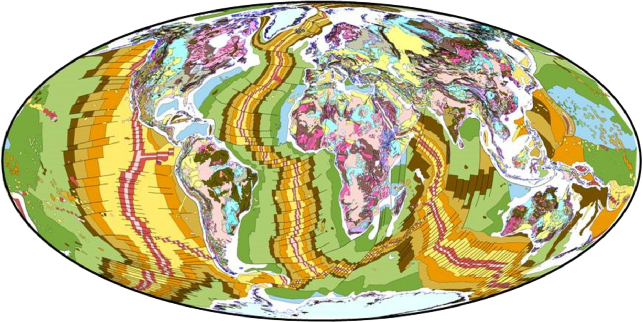The seafloor spreading hypothesis was based primarily on the magnetic mapping evidence. It was also supported by several additional lines of evidence available at the time including evidence from age dating and bathymetric surveys. At or near the crest of the mid-ocean-ridges the seafloor crustal lavas were shown to be very young and these lavas become progressively older when moving away from the ridge crests, as shown below in Mollweide equal area projection of the completed Geological Map of the World. The youngest lavas at the ridge crests always have present-day normal magnetic polarity. Moving away from the ridge crests the stripes of lava parallel to the ridges were shown to have alternated in magnetic polarity from normal to reverse to normal and so on.

Geological Map of the World showing the distribution of the various ages of rocks occurring beneath the layer of surface soils or seafloor sludge.
This suggested that the Earth’s magnetic field has reversed many times throughout its history. By explaining both the zebra-stripe like magnetic patterns and the construction of the mid-ocean-ridge system the seafloor spreading hypothesis quickly gained converts. Furthermore, this seafloor mapping is now universally appreciated to be a natural tape recording of both the history of the reversals in the Earth’s magnetic field and opening of each of the oceans.
A profound consequence of this observation of seafloor spreading is that new lava is being continually extruded along the full length of all seafloor spreading ridges. It is interesting to note that this observation was initially—and still is—considered to support the theory ofExpansion Tectonics, where new crust is being formed at the mid-ocean-ridges as a consequence of an increase in Earth radius.
History now shows that this seafloor mapping has been poorly appreciated in favour of plate tectonic theory, where excess lava generated at the mid-ocean-ridge spreading centres is presumed to disappear along seafloor trenches located along the margins of Pacific Ocean continents by an inferred process called subduction.

